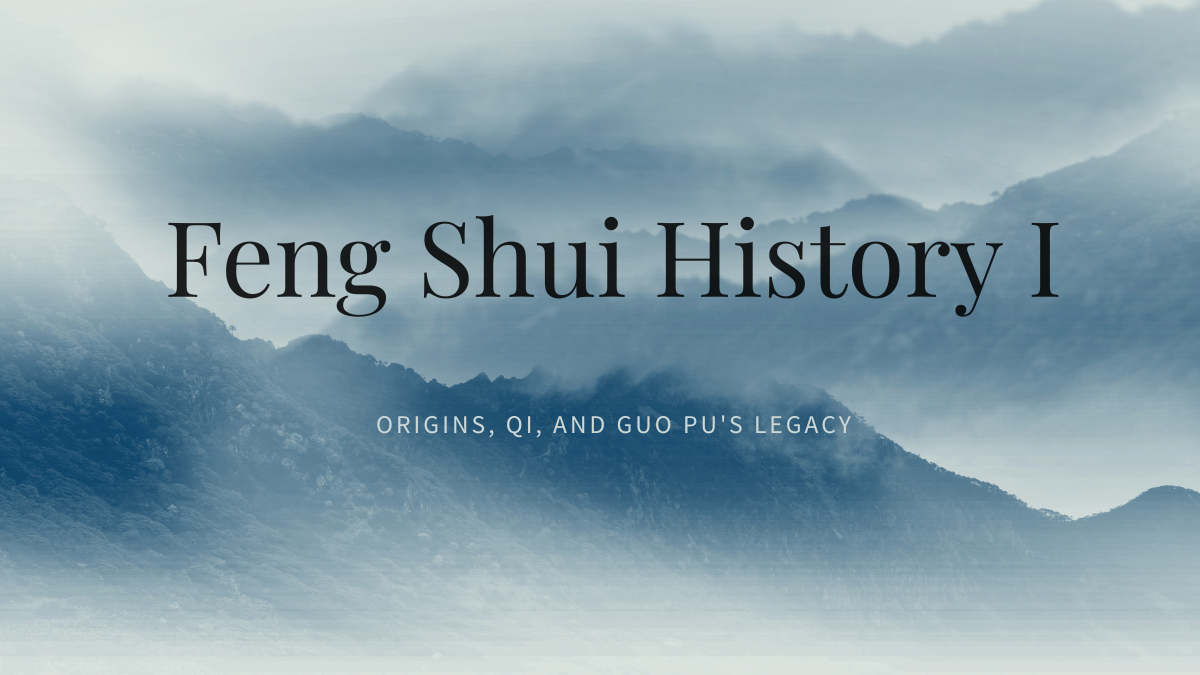The History of Feng Shui I: Origins and Early Foundations
From Ancient Chinese Cosmology to the Birth of Site Selection Practices
Introduction: Why Understanding Feng Shui’s History Matters
Feng Shui has been a way for the Chinese to communicate with nature for thousands of years. It is more than a system of choosing auspicious sites—it is a comprehensive worldview that blends astronomy, geography, philosophy, and daily living. Understanding its history is the first step in appreciating the depth of this ancient wisdom and the Chinese perspective on space and survival.
What Is Feng Shui? Early Terms and Evolving Concepts
📌 Core Concept: The Original Meaning of “Kanyu”
“Kan” refers to the heavenly way; “Yu” refers to the earthly way. Together, they describe observing the laws of heaven and earth. This term, predating the term Feng Shui, reveals the cosmological depth at the root of the practice.
Feng Shui was originally known as “Kanyu”, and over time was also referred to as:
- “Bu Zhai” (卜宅): Divining to judge the auspiciousness of a dwelling site.
- “Xiang Di” (相地): Observing and interpreting the terrain to determine suitability.
- “Tu Zhai” (圖宅): Drawing layouts of dwellings—an early form of architectural planning.
- “Xing Fa” (形法): Matching topography with spatial organization; the precursor to the Form School.
These terms are frequently found in texts from the pre-Qin to Han periods (approx. 11th century BCE to 220 CE), including the Zhouli, Book of Songs, and Book of Documents.
👤 Zhouli (Rites of Zhou) (written during the Warring States to Western Han period)
- Describes principles for planning cities and capitals, emphasizing orientation and landscape.
👤 Shangshu (Book of Documents) (content dated to approx. 11th–7th centuries BCE)
- Records location criteria such as “situating cities in river bends,” showing early attention to natural features.
📘 Etymological Note:
- The word “Kanyu” appears in Records of the Grand Historian (91 BCE, by Sima Qian) and Book of Han (1st century CE, by Ban Gu), indicating its status as a technical divinatory term.
- The term “Feng Shui” first appeared clearly in Guo Pu’s Book of Burial (276–324 CE).
The Formative Period: Pre-Qin to Han Dynasty (c. 11th Century BCE – 220 CE)
Early Feng Shui ideas arose from daily experience and environmental awareness. Ancient people favored sites that were backed by mountains, faced water, and received sunlight—all for warmth, defense, and cultivation. These intuitive preferences gradually developed into basic site selection principles.
Classical texts such as the Book of Songs, Book of Documents, and Rites of Zhou document early activities in city planning and orientation. One example, “situating cities in river bends,” reflects a recognition of advantageous terrain.
📌 Historical Example: Early Applications of Feng Shui in Urban and Burial Planning
The Western Han capital Chang’an (modern Xi’an) and the burial site of Emperor Wu (Maoling) were chosen based on classical Feng Shui principles: backed by mountain ranges, facing water, and surrounded by the Four Celestial Beasts—demonstrating the integration of geography and cosmology.
📌 Core Concept: Site Selection in Harmony with Nature
Ancient Feng Shui was rooted in adapting to nature. The ideals of “backed by mountains, facing water” and “following the sun, avoiding the wind” reflect the Chinese belief in aligning human life with the cosmic order.
👤 Dong Zhongshu (c. 179–104 BCE)
- Who: Western Han Confucian scholar
- Contribution: Introduced the doctrine of “correlation between Heaven and humanity” (tian ren gan ying).
- Impact: Provided Feng Shui with a cosmological and ethical framework, elevating it from practical knowledge to a unified theory of humans and the universe.
📌 Core Concept: How Yin-Yang and Five Elements Entered Feng Shui
Yin and Yang represent dynamic duality, and the Five Elements describe natural cycles. Dong Zhongshu’s thought helped embed these ideas in Feng Shui, shaping it into a comprehensive cosmological system.
Divination, Astronomy, and the Logic of Burial Timing
Oracle bones from the Shang dynasty (c. 1300 BCE onward) already contain records of selecting auspicious days and orientations for building. This reveals the belief that alignment with time and space is crucial for success and harmony.
📌 Supplementary Note: Early Astronomical and Geographic Thinking in Feng Shui
Ancient Chinese used the Big Dipper, seasonal sun angles, and the 28 lunar mansions to determine direction and timing. The four symbolic beasts—Azure Dragon, White Tiger, Vermilion Bird, and Black Tortoise—were linked to cardinal directions and used alongside landform assessment. Feng Shui was cosmology in practice from the very beginning.
Rational Voices and Supporters of Feng Shui
👤 Wang Chong (27–97 CE)
- Who: Eastern Han materialist philosopher
- Work: Lunheng (Critical Essays)
- Viewpoint: Criticized superstitions in Feng Shui practices such as site divination, advocating reason and observation. He represents one of the earliest rational critiques of Feng Shui.
However, many historical scholars were strong supporters and practitioners of Feng Shui. For example, the great Neo-Confucian Zhu Xi (1130–1200) was well-versed in geomancy and even wrote commentaries on related texts—showing that Feng Shui held a place in mainstream intellectual traditions.
Conclusion: The Philosophical Seeds of Feng Shui
👤 Guo Pu (276–324 CE)
- Who: Jin dynasty scholar and diviner
- Contribution: Author of the Book of Burial, the first systematic exposition of Feng Shui theory
- Core Idea: Introduced the notion of Qi and the foundational concept of “hiding wind and gathering Qi.” His text became a cornerstone of the Sanhe (Three Harmonies) School and holds an unshakable place in both theory and practice.
- Legacy: Revered as the founding father of Feng Shui.
📌 Core Concept: What Is “Hiding Wind and Gathering Qi”?
Guo Pu wrote: “Qi rides the wind and disperses, but is halted by water. The ancients gathered it to prevent dispersion and guided it to settle—hence the name Feng Shui.”
This summarizes Feng Shui’s essence: Qi is a life force that flows through the environment. Wind causes it to scatter; water helps it accumulate. The goal of Feng Shui is to find locations that shield Qi from dispersal and allow it to stay—so it can nourish life.
From intuitive living practices to an integrated system of cosmology, geography, and metaphysics, Feng Shui evolved into a philosophy of harmonizing humans with the environment. This formative phase laid the philosophical and practical foundations for later theoretical development.






